- Submissions

Full Text
Significances of Bioengineering & Biosciences
Durability and Water Absorption Properties of Fly Ash based Pervious Concrete: A Case Study
Subhakanta Dash1*, Itishree Mohanty1 and Piyush Gupta2*
1Department of Chemistry, Synergy Institute of Engineering and Technology, Dhenkanal-759001, Odisha, India
2Department of Chemistry, Faculty of Engineering and Technology, SRM Institute of Science and Technology, Delhi-NCR Campus, Delhi-Meerut Road, Modinagar-201204, Ghaziabad, Uttar Pradesh, NCR Campus, India
*Corresponding author: Subhakanta
Dash, Department of Chemistry, Synergy
Institute of Engineering and Technology,
India
Gupta P, Department of Chemistry, Faculty
of Engineering and Technology, NCR
Campus, India
Submission: July 29, 2022 Published: August 25, 2022

ISSN 2637-8078Volume5 Issue4
Abstract
Concrete is the most demanding construction material capable to consume high volumes of industrial waste such as fly ash, which is regularly generated in large quantities as a by-product in thermal power plants. A considerable quantity of fly ash remains unused and mismanaged disposal poses threat on different dimensions of environment. The development of sintered lightweight aggregate combined with fly ash is a suitable method to combat with the fly ash waste management issues. The preparation and application of pervious lightweight aggregate in concrete structure gained less attention due to absence of feasible mix design method. The durability and absorption properties of lightweight aggregate must be considered while preparing mix proportions of pervious concrete. The present study is an attempt to give a brief analysis of durability and water absorption properties of fly ash based pervious concrete (FPC) which was prepared by sintered fly ash aggregate, a more reliable and simpler than the existing methods. The experiments were carried out by exposing the fly ash based pervious concrete material towards various chemical attacks such as sodium sulphate, sulphuric acid, and seawater under different curing period. To validate the characteristics of proposed fly ash based pervious concrete material, twenty-one trail mixes were prepared employing varied water to cement and cement to aggregate proportions. The 4.75, 9.5 and 12mm aggregate sizes, an admixture and 5-15% weight of cement were used in this investigation. Test results indicated that the strength and weight loss in concrete specimens due to sodium sulphate, acid, and seawater attack increases with an increase in cement to aggregate ratio and water to cement ratio. The observations revealed that mix proportion comprising 1:3 cement to aggregate ratio exhibited better durability performance with low water absorption value over others.
Keywords: Fly ash; Waste management; Pervious concrete; Durability; Water absorption Properties; Construction material
Introduction
The construction material is mainly composed of cement, aggregate, sand, water and admixtures [1-2]. Pervious concrete (PC) finds an important application in sustainable construction. Pervious concrete is typically described as zero slump concrete, no-fine concrete, and porous concrete. It contains many voids in its body system that can trap water and pass it to the ground. The materials used in making pervious concrete are coarse aggregates, cement water, admixture, with small amount of sand [3-6]. The durability of concrete is one of the most important parameters. The durability (in terms of strength loss and weight loss of the concrete specimen is carried with exposure to various chemicals. This test is generally conducted by treating the specimens in the water curing chamber. After curing its weight is measured and the cured sample is subsequently immersed in sodium sulphate, sulphuric acid, and seawater solution for another 7, 28 and 56 days. Specimen size of (cube) 150×150×150mm is used for the study of durability and water absorption of pervious concrete [7-9]. In the water absorption test, cube samples are placed in a water chamber for 28 days to determine the percentage of water absorption. The test of concrete specimen is carried out by drying the sample in an oven for 1 hour and weighing it, followed by immersing the sample in the water at a given time and weighing it again. The difference in weight percentage (final weight of the sample to initial weight) is expressed as water absorption ratio [10,11]. A limited study is carried out to improve the durability of PC [12,13]. Various parameters such as water to cement ratio (w/c), cement paste, porosity, and size of aggregate greatly influence the properties of PC [14]. These properties can be enhanced using proper mix proportions. With the use of river sand as a partial replacement of coarse aggregate, it has been found that the compressive strength of the material in 7-days increases from 9.6-14.5MPa to 22.2-22.7MPa [15]. PC can be prepared from various naturally available coarse aggregate such as burnt brick, electric arc furnace slag, iron tailings, and municipal solid waste, etc. that showed the compressive strength for 28 days in the range of 17-34MPa, 21MPa, 11-42MPa, 4.8-12.7MPa respectively [16- 19]. Yang [20] reported that the use of smaller sized aggregate can increase the strength of the pervious concrete. However, the cement quantity must be adjusted accordingly [20]. Fu [21] observed that the compressive strength of the concrete material decreased with the increase of aggregate size [21]. Poon [22] investigated that aggregate to cement ratio (a/c) ratio is an important parameter that is governed by the compressive strength of the material. The compressive strength of the concrete material increased with a decrease in the aggregate to cement ratio [22].
Experimental Methods
Materials and mixture design
Figure 1: Typical view of sintered fly ash aggregate.

The specimen was obtained by mixing cement, aggregates, water, and admixture in a suitable proportion. The aggregates were collected from Indian Metals and Ferro Alloys Limited, Choudwar, and Odisha, India. The sintered fly ash aggregate (SFA of size 4.75, 9.5, and 12.5mm) were used in this study. The typical view of SFA is presented in Figure 1 and its physical and chemical properties are encapsulated in Table 1. In this study, twenty-one mixtures were prepared with cement to aggregate (c/a) ratio of 1:3, 1:4, 1:6, and w/c ratio of 0.30, 0.35 and 0.40 by considering suitable combinations. The mix proportion of fly ash based pervious concrete (FPC) is summarized in Table 2. Additionally, admixtures like silica fume (5-15%) and sulfonated naphthalene formaldehyde alias Conplast SP430 (7-15%) were incorporated into the mixtures to enhance the strength of the concrete material. Generally, it has been observed that admixtures increase both compressive strength and durability of concrete through their water/cement (w/c) reduction, hydrophobic effect, increased density etc. Addition of maximum amount of admixture in the concrete mix design leads to the formation of water slurry in the concrete. Due to this behaviour of admixtures, their usage has been increased tremendously in the construction industry nowadays. All the mix designs were prepared according to the ASTM and IS standards.
Table 1: Physical and mechanical properties of sintered fly ash aggregate.

Table 2: Mix design of fly ash based pervious concrete.
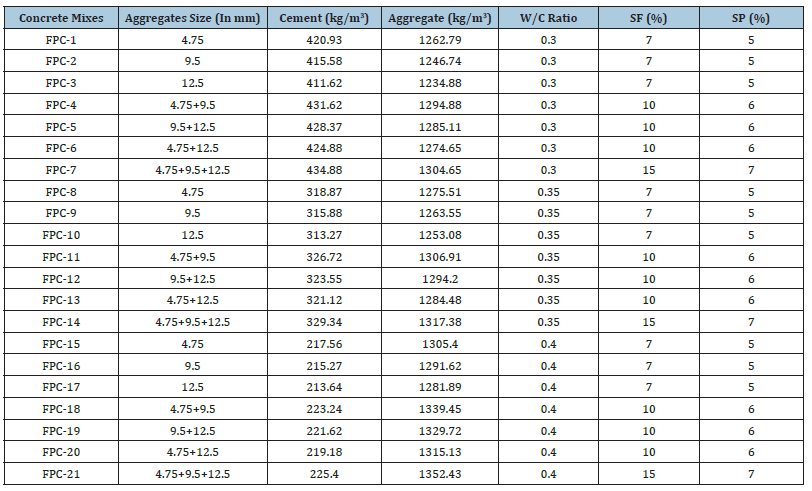
Specimen preparation
Figure 2: Laboratory method for preparing fly ash based pervious concrete.
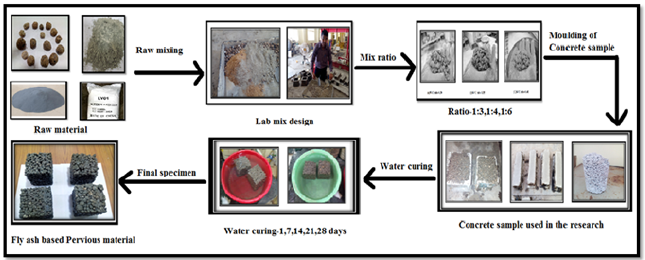
The compaction method was adopted for the preparation of a concrete specimen. Initially, aggregate and cement were mixed in a pan mixer (80 l capacity) for 3 mins then an admixture was added to the mixture and again mixed for 2 mins. The mixture was placed into a mould and 25 manual strokes were given using an iron rod. The mould was then placed on a vibrating table for 2-3 mins. Samples were removed from the mould after 24 hours and allowed to cure for 7, 14 and 28 days for achieving good strength. The laboratory preparation of fly ash based pervious concrete is shown in Figure 2.
Experimental Studies
Durability test
Durability of concrete is one of the most important parameters in predicting its capability to meet the long-term requirement. Durability tests are generally carried out to know the change in both compressive strength and weight reduction (ASTM 1247-14) [23]. The durability test was conducted by curing cubes in different solutions of 10% Na2SO4, 10% of H2SO4 and seawater for 7 days, 28 days and 56 days respectively. The specimen size of 150×150× 150mm cube was used for the study purpose. The first weight of the known volume of the oven-dried sample was taken and then the mass of the sample per unit volume was calculated. The weight loss is another parameter to measure the durability characteristics of the concrete specimen. The weight losses of the concrete specimens are calculated by measuring the initial and final weight of the concrete specimen before and after the chemical exposures. Finally, the compressive strength loss and weight loss (%) has been calculated as follows:
Compressive strength loss = (σ CB-σ CA) …………………………... (1)
Where, σ CB = compressive strength of the sample before chemical curing
σ CA = compressive strength of the sample after chemical curing
Weight loss (%) = (WInitial–WFinal/WInitial) ×100…………………... (2)
Where, WInitial = weight of the concrete specimen before chemical exposure
WFinal = weight of the concrete specimen after chemical exposure
Water absorption test
A special water chamber fabricated using fiber was prepared with a dimension of length x breadth x height equal to 18.5cm × 13.5cm × 18.5cm. In this chamber, a sample container was attached at a height of 3.5cm above the base surface. A water marker indicator of 50ml was attached to indicate the water level in the chamber. Apart from these four no’s of 5mm rods were fixed to support the sample container. The specimen size of 150×150×150mm cube was used in this study. This specimen was allowed to dry in oven for 24 hours to achieve a constant mass and weighed (ASTM 1585-13) [24]. The dry weight of the block is noted as W1. The wet weight of the sample is noted as W2. The water absorption (%) is calculated by using the formula:
Water absorption (%) = [(W2-W1) / W1] × 100 ………..…………... (3)
where, W1 = weight of the oven-dried specimen in grams
W2 = weight of the wet cube after 3.5 hours in grams
Results and Discussion
Effect of size of coarse aggregate and cement to the aggregate ratio (c/a) on concrete
The size of aggregate plays an important role in strength properties of the concrete material. In the present study, it was observed that as the size of aggregate increases, the compressive strength of concrete material decreases. The larger the aggregate size, greater the surface area that leads to fewer the number of contact points between the unit volume of coarse aggregate nonfine concrete, smaller the glue bond area, thereby resulting increase in the water permeability of non-fine concrete with a decrease in compressive strength. The aggregate size is an important factor influencing the compressive strength as well as pore volume of pervious concrete. During the mix designs, it was observed that when the size of aggregates becomes larger, contact between adjacent aggregates enhances, results in increase in pore volume. Similarly, in the small size of aggregate, the contact between adjacent aggregate is more, resulting in more compressive strength but less porosity. But in a mixture of different sizes of aggregate, it is found that systematic packing between the aggregate results in good compressive strength and good permeability. The water to cement (w/c) ratio also plays a vital role during the concrete mix design. A lower ratio leads to higher strength and durability but make the mix difficult to work with. A higher value of the w/c ratio may lead to lower strength, reduced durability, shrinkage cracking and a variety of surface problems. Thus, a proper amount of water is added to concrete and other cement mixes. The greater the amount of water in a concrete mix, the cement paste will be more diluted which will not only affect the compressive strength, but also the tensile and flexural strengths, the porosity, the shrinkage, and the color. The strength is reduced mostly because of the addition of more water that weakens the binding capacity. By increasing the ratio w/c, strength decreases. However, water is necessary for the hydration of cement, which leads to an increase in strength. Excess amount of water after that for hydration will leave more capillary pores which decreases the area of solid hydrates for the same crosssectional area of concrete and consequently decreases the strength.
Resistance to sulphate attack
The sulphate attack takes place through a series of chemical reactions. Initially sulphates enter concrete material and start combining with the cement paste, and then spoil the paste. As sulphate dries, it forms new compounds called gypsum and ettringite (hydrous calcium aluminium sulphate mineral with formula: (Ca6Al2(SO4)3(OH)12·26H2O). Gypsum causes softening and strength loss and is also reported to cause expansion [25,26]. The reaction of gypsum with aluminates C3A and its hydrates leads to the formation of ettringite. This section focuses on the behaviour of all twenty-one types of the specimen with a definite water curing period subjected to various ages of sulphate (Na2SO4 solution) attack. The highest percentage of strength loss and weight loss was found in the mixed design range of FPC-15 to FPC-21 followed by a linear reduction in FPC-8 to FPC-14. However, it is interesting to note that the decreasing trend was found low in FPC-1 to FPC- 7 mix design. The details of the percentage of strength loss and weight loss (at 56 days) of the specimen are given below in Table 3. The highest loss in compressive strength is observed in FPC-17 is 3.25MPa followed by FPC-14 is 9.38MPa and FPC-7 is 13.50MPa respectively. Similarly, the maximum percentage of weight loss found in the mix design of FPC-17 is 54.54% followed by FPC-14 is 29.36 and FPC-7 is 22.41% respectively. The variation of strength loss and weight loss in the sulphate solution is shown in Figure 3.
Table 3: Compressive strength (CS) loss and weight loss (WL %) of FPC in sulphate solution.
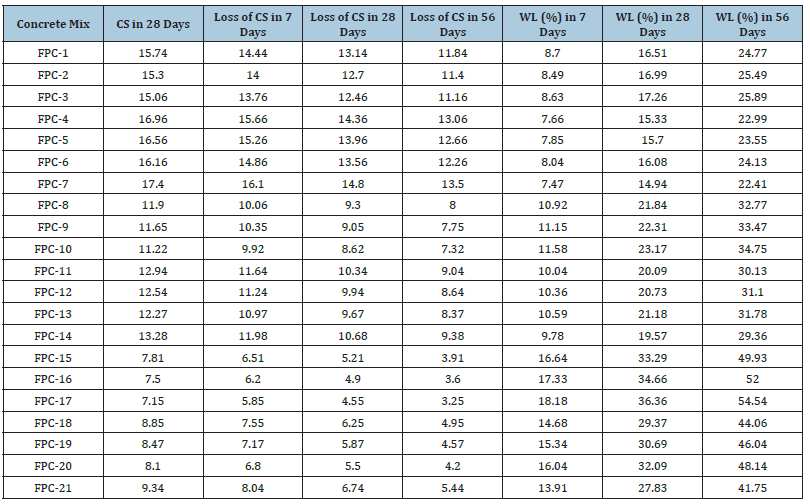
Figure 3: Variation in strength loss and weight loss of concrete specimen in sulphate solution.

Resistance to acid attack
The sulphuric acid first reacts with calcium hydroxide (available in the hydrated cement paste) to form calcium sulphate which makes cement paste porous and weaker. It again reacts with the tricalcium aluminate phase present in the cement hydration to form ettringite. The above mechanism is given below.

The excess growth of ettringite causes expansion, spalling, and cracking of the concrete. Later acid reacts with the C-S-H phase resulted in the formation of silica and gypsum.

This section focuses on the behavior of all the twenty-one types of the specimen with a distinct water curing period when subjected to various ages of sulphuric acid (H2SO4 solution) attack. The details of the percentage of strength loss and weight loss (at 56 days) of specimens are tabulated in Table 4. It is observed that the loss in compressive strength increases with the increase in curing days. The maximum loss in compressive strength found in the mix design of FPC-17 is 0.15MPa followed by FPC-14 is 6.28MPa and FPC-7 is 10.40MPa respectively. Similarly, the highest percentage of weight loss is found in FPC-17 is 77.90% followed by FPC-14 is 52.71% and FPC-7 is 40.22%. The variation in strength loss and weight loss in acid solution is shown in Figure 4.
Table 4: Compressive strength (CS) and weight loss (WL) (%) of FPC in acid solution.
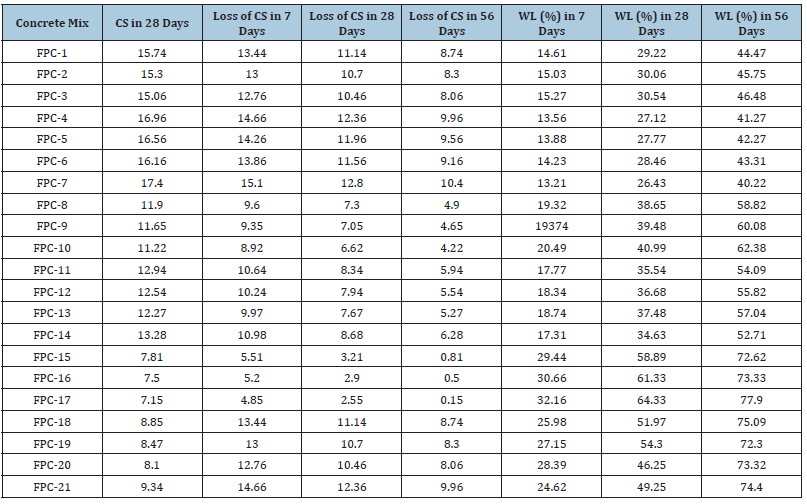
Figure 4: Variation in strength loss and weight loss of concrete specimen in sulphuric acid solution.
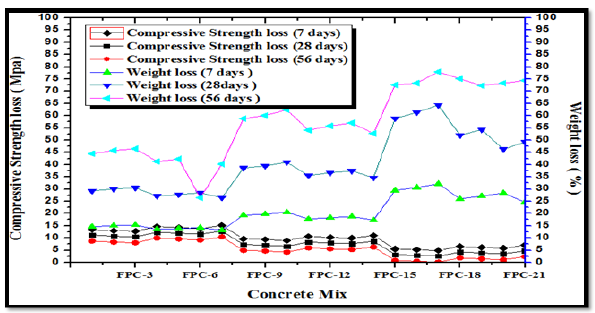
Resistance to seawater attack
Generally, Wegian FM [27] explained seawater is composed of sulphates and chlorides of sodium and magnesium ions [27]. The magnesium sulphate reacts with calcium hydroxide of cement to forms calcium sulfate and magnesium hydroxide. Further, the sulphate and magnesium ion cause a weakening action of cement paste. However, chloride ion present in the seawater penetrates the concrete material and cause corrosion.

This section focuses on the behavior of all the twenty-one types of the specimen with a definite water curing period when subjected to various ages of seawater attack. The details of the percentage of strength loss and weight loss (at 56 days) of the specimen are mentioned below in Table 5. It is found that strength loss and weight loss is gradually increased when the exposure time increases. The maximum compressive strength loss found in mix design FPC-17 is 0.85MPa followed by FPC-14 is 6.98MPa and FPC-7 is 11.10MPa respectively. Similarly, the maximum percentage of weight loss found in FPC-17 is 67.45% followed by FPC-14 is 47.43% and FPC- 7 is 36.20% respectively. The variation in strength loss and weight loss in the seawater solution is shown in Figure 5. The strength loss in the case of a saltwater attack is low because of the incorporation of admixture in the concrete.
Table 5: Compressive strength (CS) loss and weight loss (CS %) of FPC in seawater solution.

Figure 5: Variation in strength loss and weight loss of concrete specimen in seawater.
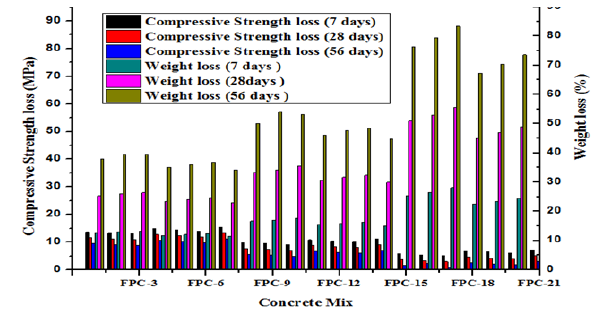
The following parameters should be adopted to improve the durability of concrete structures. These are a suitable design mix, proper construction joints, avoiding premature moisture loss, lower permeability, curing, and avoiding frequent wetting and drying.
Effect of curing days on water absorption
The water absorption value of concrete material gradually decreases with an increase in the curing period as illustrated in Table 6. The variation of water absorption value of pervious concrete mainly depends on the different amount of cement to aggregate ratio and addition of a variable percentage of naphthalene-based superplasticizer (water reducer). The variation of water absorption value with the concrete mix is shown in Figure 6.
Table 6: Water absorption value of fly ash based pervious concrete (FPC).

Figure 6: Variation of water absorption value with concrete mix.
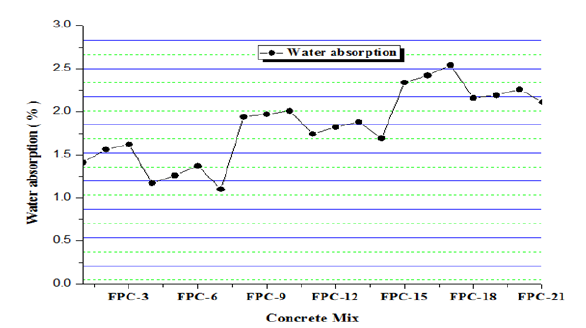
Conclusion
The main conclusions drawn from the studies on durability and
water absorption properties of FPC are depicted as below:
A. Pervious concretes made up of sintered fly ash aggregates
had a satisfactory compressive strength value of 17.40MPa
as compared to other natural available aggregates which
make FPC useful for applying in low-traffic parking area. By
mixing the appropriate amount of admixture and cementitious
materials compressive strength of the material can be
improved.
B. It was observed that the fabrication of FPC with large size
(12mm) of the aggregate causes large pore volume and greater
surface area. Less point of contact between the aggregate
decreases compressive strength and increases water
permeability. Alternatively, for FPC prepared by small size
(4.75mm) of aggregate, it appears that the contact between
aggregate is more, resulting in more compressive strength
but less porosity. But FPC produced by a mixture of different
sizes of aggregate (4.75, 9.5 and 12mm) causes systematic
packing between the aggregate, resulting in good compressive
strength and good permeability. So, the suitable mix design of
FPC observed is the mixture of various size of aggregate i.e.,
4.75, 9.5 and 12mm.
C. The concrete mix design FPC 1-7 showed high durability (in
terms of strength loss and weight loss) followed by FPC 8-14
and FPC 15-21.
D. It is observed that an increase in the c/a and w/c ratio resulted
in a decrease in the compressive strength and increases the
water absorption value of the concrete material.
Overall, the mix design FPC-14 showed the compressive strength of 13.28 MPa with a water absorption value of 1.69%, which can be treated as an optimum mix design and recommended for the fabrication of fly ash based pervious concrete.
References
- Crouch LK, Pitt J, Hewitt R (2007) Aggregate effects on pervious portland cement concrete static modulus of elasticity. Journal of Material in Civil Engineering 19(7).
- Darshan SS, Pitroda JK, Bhavsar JJ (2013) Pervious concrete: new era for rural road pavement. International Journal of Engineering Trends and Technology 4(8): 3495-3499.
- Ghafoori N, Dutta S (1995) Building and no pavement applications of no-fines concrete. Journal of Materials in Civil Engineering 7(4).
- Khalfan MMA, Bouchlaghem NM, Anumba CJ, Carrillo PM, Glass J (2002) Managing sustainability knowledge for a sustainable built environment. Department of Civil and Building Engineering, Loughborough University, UK.
- Luck JD, Workman SR, Higgins SF, Coyne MS (2006) Hydrologic properties of pervious concrete. American Society of Agricultural and Biological Engineers 49(6): 1807-1813.
- Montes F, Valavala S, Haselbach LM (2005) A new test method for porosity measurements of portland cement pervious concrete. Journal of ASTM International 2(1).
- Meininger RC (1988) No fines pervious concrete for paving. International Concrete Abstracts Portal 10(8): 20-27.
- Park SB, Tia M (2004) An experimental study on the water-purification properties of porous concrete. Cement and Concrete Research 34(2): 177-184.
- Rushton BT (2001) Low-impact parking lot design reduces runoff and pollutant loads. Journal of Water Resources Planning and Management 127(3): 172-179.
- Ajamu SO, Jimoh A, Oluremi JR (2012) Evaluation of the structural performance of pervious concrete in construction. International Journal of Engineering and Technology 2(5): 829-836.
- Ravindrarajah R, Aoki Y (2008) Environmentally friendly porous concrete. The Proceedings of the second International Conference on Advances in Concrete and Construction, Hyderabad, India.
- Deo O, Neithalath N (2010) Compressive behaviour of pervious concretes and quantification of the influence of random pore structure features. Materials Science and Engineering: A 528(1): 402-412.
- Lian C, Zhuge Y (2010) Optimum mix design of the enhanced permeable concrete -an experimental investigation. Construction Building Materials 24(12): 2664-2671.
- Girish G, Manjunath R (2011) A step towards mix proportioning guidelines for pervious concrete. International Journal of Earth Sciences and Engineering 4: 768-771.
- Milani S, Narayanan N (2011) Pore structure features of pervious concrete proportioned for desired porosities and their performance prediction. Cement and Concrete Composites 33(8): 778-787.
- Debnath B, Sarkar PP (2020) Characterization of pervious concrete using over burnt brick as coarse aggregate. Construction and Building Materials 242: 118154.
- Yeih W, Fu TC, Chang JJ, Huang R (2015) Properties of pervious concrete made with air-cooling electric arc furnace slag as aggregates. Construction and Building Materials 93: 737-745.
- Tan Y, Zhu Y, Xiao H (2020) Evaluation of the hydraulic physical and mechanical properties of pervious concrete using iron tailings as coarse aggregates. Applied Science 10(8): 2691.
- Kuo WT, Liu CC, Su DS (2013) Use of municipal solid incinerator bottom ash in pervious concrete. Cement and Concrete Composites 37: 328-335.
- Yang J, Jiang G (2003) Experimental study on properties of pervious concrete pavement materials. Construction and Building Material 33(3): 381-386.
- Fu TF, Yeih W, Chang JJ, Huang R (2014) The influence of aggregate size and binder material on the properties of pervious concrete. Advances in Materials Science and Engineering 1-17.
- Poon CS, Lam CS (2008) The effect of aggregate-to-cement ratio and types of aggregates on the properties of pre-cast concrete blocks. Cement and Concrete Composites 30(4): 283-289.
- ASTM (C1247-14) Standard test for durability test of concrete specimen. American Society for Testing Materials, West Conshohocken, Pennsylvania, USA.
- ASTM (C1585-13) Standard test for water absorption of concrete specimen. American Society for Testing Materials, West Conshohocken, Pennsylvania, USA.
- Patel SK, Majhi RK, Satpathy HP, Nayak AN (2019) Durability and microstructural properties of lightweight concrete manufactured with fly ash cenosphere and sintered fly ash aggregate. Construction and Building Material 226: 579-590.
- Neithalath N, Sumanasooriya Ms, Deo O (2010) Characterizing pore volume sizes and connectivity in pervious concrete towards permeability prediction. Material Characterization 61(8): 802-813.
- Wegian FM (2010) Effect of seawater for mixing and curing on structural concrete. The IES Journal Part A: Civil and Structural Engineering 3(4).
© 2022 © Subhakanta Dash. This is an open access article distributed under the terms of the Creative Commons Attribution License , which permits unrestricted use, distribution, and build upon your work non-commercially.
 a Creative Commons Attribution 4.0 International License. Based on a work at www.crimsonpublishers.com.
Best viewed in
a Creative Commons Attribution 4.0 International License. Based on a work at www.crimsonpublishers.com.
Best viewed in 







.jpg)






























 Editorial Board Registrations
Editorial Board Registrations Submit your Article
Submit your Article Refer a Friend
Refer a Friend Advertise With Us
Advertise With Us
.jpg)






.jpg)














.bmp)
.jpg)
.png)
.jpg)










.jpg)






.png)

.png)



.png)






